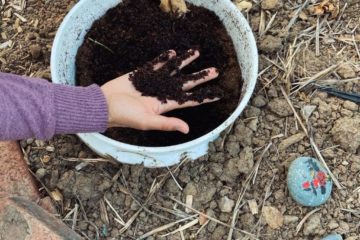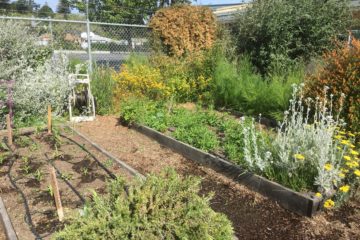By Madison Main, Horticulture and Design intern
Do you have limited space, an abundance of pavement, or poor soil quality? If so, raised beds might just be the perfect solution! Here at Each Green Corner, we include raised planting beds in just about every garden we work with. Here are some benefits to consider if you’re wondering whether or not raised beds are right for you.
Benefits
Ease of Access
Raised beds can be built at any height, allowing gardeners easy access to the plot. This feature can make raised beds especially helpful for garden enthusiasts who are mobility impared. The edge of the raised bed can also be widened, providing gardeners with a built-in bench to work from.
Effective Resource Use
Raised beds present a smaller, more easily controlled environment than in-ground plots. This means that gardeners can better ensure that they are using the appropriate amount of water, mulch, and fertilizer for their plants. Furthermore, it becomes far easier to make soil amendments when your only focus is on the soil contained within your raised bed. You can adjust the native soil with organic material and tailor the soil drainage, pH, and nutrient composition to the specific plants you want to grow.
Prevent Soil Compaction
Soil compaction is the condensing of soil particles. The soil is compressed by heavy machinery or by heavy foot traffic, resulting in an increase in the soil density. The roots of plants grown in compacted soil have less access to water, nutrients, and air. By growing plants in raised beds, you can prevent the potential plant damage caused in more public areas.
Extend the Growing Season
In the spring, the soil contained in raised beds warms up faster, allowing for gardeners to begin planting earlier in the season. Furthermore, you can easily convert your raised beds into cold frames during the winter. A cold frame is essentially a box placed over plants that utilize solar energy and insulation to prevent plant damage from cold weather, allowing you to extend the growing season during the winter months.
Less Maintenance
Plants grown in raised beds can require less regular maintenance than plants grown directly in the ground. Raised beds are less prone to weeds. By keeping your desired plants elevated, you remove them from the surrounding weed populations. Additionally, you can fill the raised bed with soil that is less likely to carry weeds or disease.
Construction
If you’ve decided that raised beds are the right option for your garden, there are a variety of construction options available. Anyone can build their own raised bed regardless of construction experience! Find a level spot that gets 6-8 hours of sunlight and you’re ready to get started. If your toolkit is limited, click here to find instructions on building a raised bed with only a sledgehammer. There are also commercial kits that come with instructions and the required materials available for purchase at most home improvement and garden stores. Here are some tips and general information if you’ve decided to design and build your own raised bed.
Site Selection
Beyond considering the sun exposure of your potential site, you should consider access to water. Raised beds typically require careful irrigation design or hand watering. Either way, it’s important to place your raised bed near a water source.
Materials
You can essentially use any material that will not leach heavy metals and that are capable of holding soil. Some popular materials include pressure treated pine, rot-resistant hardwood, composite material made of wood or plastic, and concrete blocks. You also might need rebar or wooden stakes and galvanized nails or screws to hold your raised bed together.
Dimensions
The first step in constructing your raised bed is to determine the appropriate height, length, and width. Generally, raised beds should not be wider than 4 feet to ensure ease of access. Additionally, raised beds should be a minimum of 6-12 inches deep to provide enough space for root growth. Beyond these basic guidelines, you can design your raised bed to be any shape!
Site Preparation
In order to maximize the longevity, drainage, and irrigation of your raised bed, you must ensure that your site is level before you begin construction.
Soil
For ideal plant growth, the soil should be comprised of 10-20% of compost and no more than 50% of organic matter. One popular choice is to fill the raised bed with a mixture of native soil taken from the site and compost. You can also test your soil to identify more specific soil amendments that might need to be made.
Click here to see a video on how to build a raised bed by The Old Farmer’s Almanac!
References:
(All image sources: EGC work days at Arroyo Upper Elementary School and Arundel Elementary School)
Berle, D. & Westerflied, R. (2013, February). Raised Beds vs. In-Ground Gardens. University of Georgia Extension. https://extension.uga.edu/publications/detail.html?number=C1027-3&title=Raised%20Beds%20vs.%20In-Ground%20Gardens
Erler, E. (2019, March 26). What are the benefits of raised beds and how can I construct one myself?. University of New Hampshire Extension. https://extension.unh.edu/blog/what-are-benefits-raised-beds-and-how-can-i-construct-one-myself
Soil Compaction. (n.d.) University of Minnesota Extension. Retrieved December 25, 2020, from https://extension.umn.edu/soil-management-and-health/soil-compaction#:~:text=Soil%20compaction%20increases%20soil%20density,soil%20for%20nutrients%20and%20moisture.
Symonds, S. (2020, June 30). Easy Raised Garden Bed. Grace in My Space. https://graceinmyspace.com/easy-raised-garden-bed-diy-without-tools/
The Old Farmer’s Almanac. (2020, January 10). How to Build a Raised Garden Bed. https://www.almanac.com/content/how-build-raised-garden-bed



0 Comments